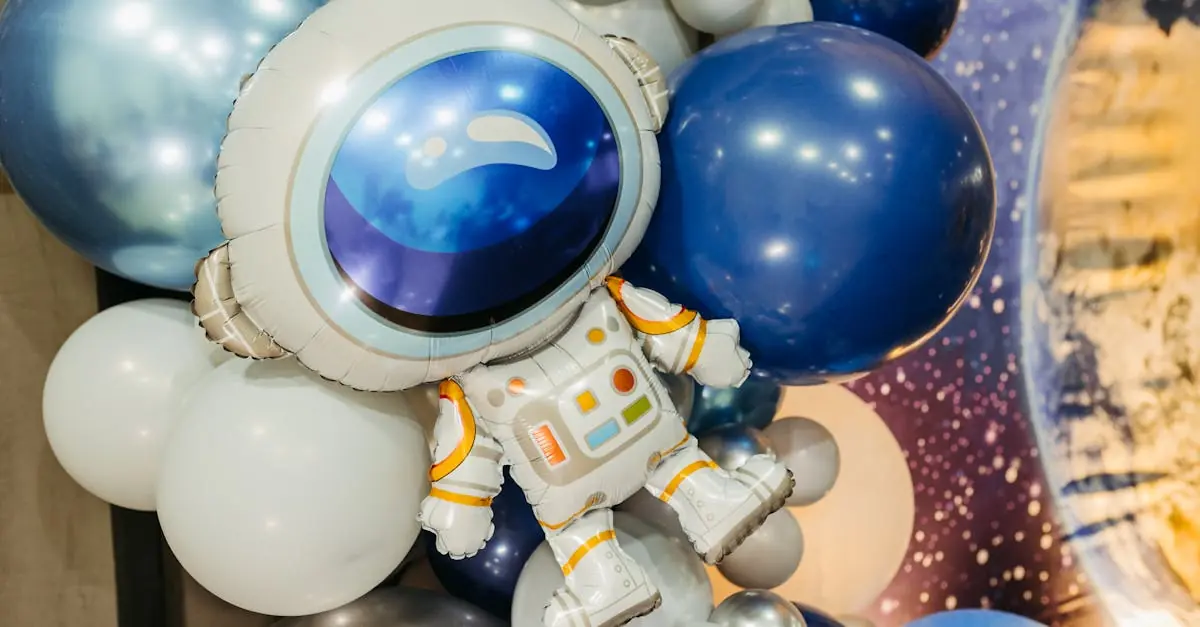Table of Contents
ToggleImagine floating through the cosmos, sipping space coffee in a cozy inflatable habitat that feels more like a luxury hotel than a steel box. Inflatable space habitats are revolutionizing the way we think about living and working in space. They promise to make astronauts feel right at home among the stars, all while being as light as a feather and easy to deploy.
Overview of Inflatable Space Habitats
Inflatable space habitats represent a significant advancement in space exploration technology. Designed for ease of transport, these structures can fold into compact forms during launch. Once in space, they expand to provide much-needed living and working spaces for astronauts.
These habitats often prioritize comfort, simulating environments similar to luxury hotels. A range of materials creates durable yet lightweight walls, which enhance insulation and protection against space radiation. NASA’s BEAM (Bigelow Expandable Activity Module) serves as a prominent example, demonstrating the feasibility and benefits of inflatable designs in orbit.
Deployment occurs rapidly, often within hours, making them ideal for quick setups during missions. They also offer flexibility, allowing for scaling to accommodate varying mission needs. Habitats can support different crew sizes and specific functionality, such as laboratories or greenhouse systems.
Research indicates that inflatable habitats could reduce costs associated with traditional rigid habitats, which require extensive materials and complex assembly methods. In addition, the modular aspect of inflatable habitats permits easy reconfiguration or expansion as missions evolve or extend.
Collaboration with private companies enhances innovation, encouraging designs that meet the challenges of space living. These partnerships foster ongoing developments, ensuring continuous improvements in sustainability and efficiency. As exploration missions to the Moon and Mars gain traction, inflatable space habitats are positioned to play a vital role in future living arrangements in these extraterrestrial environments.
Design and Structure
Inflatable space habitats incorporate advanced materials and engineering innovations to enhance functionality in space environments. These aspects significantly impact astronaut comfort and mission success.
Materials Used
Durable materials provide critical protection against space radiation and temperature extremes. NASA employs advanced fabrics like Vectran and Kevlar, known for their strength-to-weight ratios. Each material undergoes rigorous testing to ensure reliability in harsh space conditions. Insulation layers optimize thermal performance, maintaining stable habitats. Collaborative efforts with private aerospace companies lead to the development of unique composites, ensuring adaptability and efficiency for long missions. Such innovations in material science directly influence the long-term viability of inflatable habitats.
Engineering Innovations
Innovative engineering techniques streamline habitat deployment and enhance functionality. Modular designs allow habitats to expand or be reconfigured based on mission needs. Engineers integrate automated systems for rapid inflation, significantly reducing setup time to mere hours. Smart materials contribute to self-repair capabilities, improving long-term durability. These engineering advancements emphasize sustainability and reduce reliance on finite resources. Continuous improvements stem from partnerships between governmental organizations and private enterprises, fostering a groundbreaking approach to creating living spaces in orbit.
Benefits of Inflatable Space Habitats
Inflatable space habitats offer numerous advantages that transform space living and working conditions. These benefits encompass cost savings, enhanced space availability, and adaptability for varied mission requirements.
Cost-Effectiveness
Cost savings accompany the use of inflatable habitats. Rigid structures demand extensive materials, resulting in higher launch expenses. In contrast, inflatable habitats utilize lightweight materials that fold into compact shapes, significantly reducing transportation costs. Research shows the modular design permits easier assembly and less labor, leading to further savings on missions. Reduced resource use translates into budget-friendly missions, making them attractive for both governmental and private space endeavors.
Increased Living Space
Increased living space represents another key benefit. Inflatable habitats expand upon arrival in space, providing astronauts with more room than traditional habitats. Modular features enable customization, allowing habitats to serve various functions such as laboratories or lounges. Occupants enjoy enhanced comfort levels with the additional space and can engage in recreational activities, promoting mental well-being. Flexibility in design accommodates diverse crew sizes and mission activities, ensuring adaptability and functionality throughout exploration missions.
Applications and Use Cases
Inflatable space habitats serve various functions, aligning with both scientific exploration and commercial ventures.
Research Missions
Research missions utilize inflatable habitats as essential tools for studying environments in space. Scientists carry out experiments with minimal risk to crew comfort and productivity. These habitats can support diverse research activities, from biological studies to materials experiments. Their flexible design allows for quick adaptations to mission needs, accommodating larger teams or specialized equipment. NASA’s deployment of the BEAM module demonstrates how inflatable habitats enhance long-duration research projects. Examples of experiments conducted in such habitats include testing the effects of microgravity on plant growth and observing human physiology in space.
Commercial Space Travel
Commercial space travel also benefits from inflatable habitats, underscoring their versatility for private enterprises. Companies like SpaceX and Blue Origin envision future tourism ventures that incorporate these habitats. With adaptable designs, guests can experience luxurious amenities during their stay in orbit. Inflatable configurations facilitate easy transport, significantly influencing design decisions for space hotels or research stations. Innovations in materials ensure a balance between comfort and safety, attracting investors to the burgeoning space tourism market. The combination of flexible living spaces and cost reductions ultimately positions inflatable habitats as vital components of commercial space missions.
Challenges and Limitations
Inflatable space habitats face various challenges and limitations that impact their viability in space missions. Addressing these concerns is crucial for the success of future exploration.
Safety Concerns
Safety is a top priority for inflatable space habitats. In the harsh environment of space, potential exposure to micrometeoroids poses a significant risk, requiring robust shielding. Additionally, leak detection and repair systems are essential since any breach could compromise the atmosphere within. Research shows that durability against radiation damage is vital to protect both the structure and the crew. Manufacturers must also focus on fire safety measures, ensuring that materials used can withstand potential fire hazards. Collaborative efforts between organizations further bolster safety protocols and foster innovative solutions to enhance astronaut protection.
Durability Issues
Durability remains a critical issue concerning inflatable space habitats. Over time, materials can degrade due to exposure to radiation and temperature extremes. High-energy particles from solar activity can weaken structural integrity, making ongoing assessments necessary. The need for regular maintenance complicates long-duration missions, as the habitats must endure multiple years in demanding conditions. Furthermore, tensile strength and abrasion resistance of fabrics can decline, raising concerns about long-term reliability. Manufacturers prioritize newer materials like advanced composites to improve lifespan, yet ongoing research and testing are essential for ensuring mission success and astronaut safety.
Future Prospects
Inflatable space habitats hold exciting possibilities for space exploration and commercialization. As technology continues to advance, several upcoming projects aim to increase their application in various missions.
Upcoming Projects
NASA’s Lunar Gateway initiative plans to utilize inflatable habitats to support missions on the Moon. The collaboration with private companies focuses on developing habitats that can sustain human life during extended stays. Additionally, the European Space Agency is exploring inflatable modules for Mars missions, prioritizing durability and adaptability. Research and development programs aim to enhance materials and deployable designs, ensuring these habitats meet the rigorous demands of human spaceflight.
Impact on Space Exploration
Impact on space exploration cannot be underestimated. Inflatable habitats promise to decrease the costs associated with traditional space infrastructure. Enhanced adaptability allows for diverse mission functionalities, accommodating scientific research, habitat compression, and recreational activities. These habitats enable longer missions by providing astronauts with comfortable living spaces, improving their mental well-being during extended stays. Overall, inflatable habitats create opportunities for innovative exploration strategies and the potential for permanent human presence beyond Earth.
Conclusion
Inflatable space habitats are set to redefine the future of human presence in space. With their lightweight design and rapid deployment capabilities, they offer a versatile solution for both exploration and commercial ventures. The advancements in materials and engineering ensure that these habitats can withstand the harsh conditions of space while providing comfort and adaptability for astronauts.
As space agencies and private companies continue to innovate, the potential for inflatable habitats grows. They promise not only to enhance the quality of life for crews during missions but also to pave the way for sustainable practices in space exploration. The journey toward establishing a permanent human presence beyond Earth is becoming increasingly tangible with these transformative structures.




